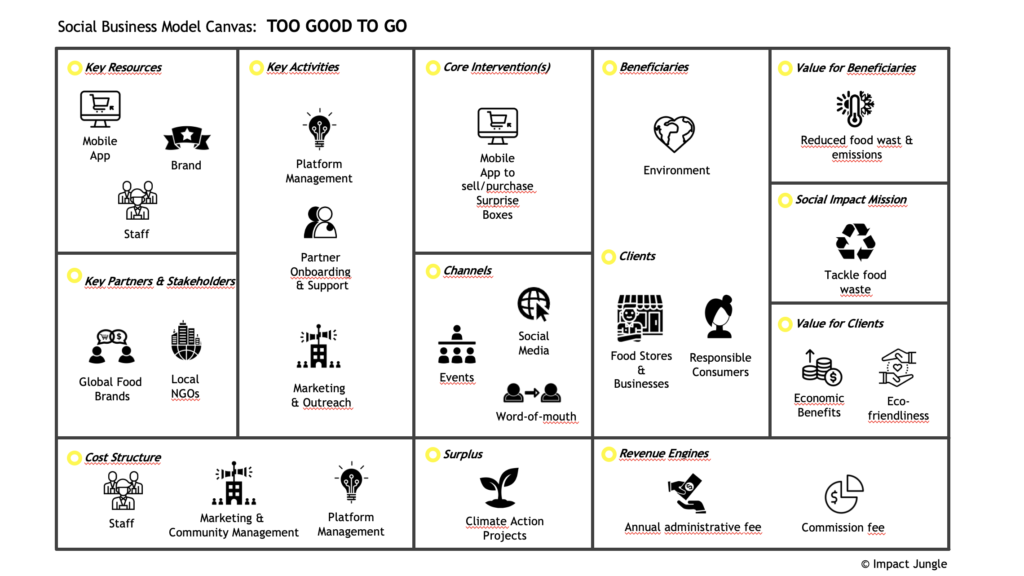
TOO GOOD TO GO BUSINESS MODEL
“BEYOND LEFTOVERS”: SAVING THE PLANET, ONE MEAL AT THE TIME
Copenhagen is one of those cities renowned for its vibrant culture, historic landmarks and culinary delights. And here is where a group of university students, back in 2015, stumbled upon a transformative, disruptive idea to combat food waste: offering a second chance to delicious, unsold food leftovers. From there, Too Good To Go was founded.
Ever since that day, Too Good To Go became a remarkable example of a social enterprise that has significantly impacted reducing food waste on a global scale. Thanks to innovative, tech-driven approach, the company managed to connect customers with bars, restaurants and local stores that have surplus unsold food, providing economic benefit to both consumers and businesses while addressing a critical environmental issue.
As we delve into this case study, we uncover and present Too Good To Go business model, the true enabler that turned this company into the world’s largest marketplace for surplus food.
Problem in context
Food waste is a pressing global challenge with far-reaching repercussions for our environment, as well as for the economy and local communities.
According to the World Economic Forum, in 2023 food waste contributed to roughly half of the global food system emissions. Adding to that, approximately 6% of the world’s total emissions were associated to food waste, for over 3 billion tonnes of CO2 equivalent of greenhouse gases released into the atmosphere each year. Here, the disposal methods dramatically contributed to methane emissions, as a significant portion of food waste ended up in landfills. Not to count additional implications on water and land consumption.
This not only exacerbates and accelerates climate change, but also squanders valuable economic resources. As a matter of fact, EU alone generated over 58 million tonnes of food waste annually (Eurostat, 2023), with an estimated lost market value of €132 billion. As multifaceted as it is, in EU and high-income regions the issue of food waste is more pronounced at the retail and consumer levels, whereas in developing countries remains at the production change. Bottlenecks and inefficiencies thus change from country to country, but the output remains the same.
Efforts to address this issue have been made, including both global initiatives (like the World Bank, allocating up to $30 billion to strengthen food systems) and locally-based ones. These efforts highlight the urgent need for sustainable changes across the food supply chain to mitigate environmental impact and economic losses. And in this intersection Too Good To Go (TGTG) found its way in.
Too Good To Go Business Model
Too Good To Go has a unique business model, revising more typical matchmaking models already analyzed here at Impact Jungle.
In order to addresses food waste, TGTG connects indeed consumers with local bars, restaurants and food businesses offering surplus food, at a discounted price. Leveraging a geo-localized, mobile-first platform, the company brings together the two sides of this market: sellers with food leftovers and conscious consumers. This way, the company helps reduce food waste and promotes sustainability, while generating economic benefits to both parties involved. A win-win-win situation for businesses, consumers, as well as the environment.
Having scalability at the very core of its digital product, TGTG has been able to scale worldwide since its inception. Today, the company operates in more than 17 countries across Europe and North America, partnering with over 100,000 local stores. As of 2023, Too Good To Go announced a milestone of saving over 200 million meals from landfills and reached over 75 million registered users. Astonishing numbers, right?
Let’s now delve further into TGTG business model, using the Social Business Model Canvas, to better understand how it managed to achieve these incredible results.
De-coding Too Good To Go: Social Business Model Canvas
If by now you haven’t grasped what this Canvas is all about, we strongly advise you to read this article on our platform. If you have any question, as always, feel free to drop us a message! 🙂
This said, let’s now break down TGTG business model using the Social Business Model Canvas

Adapted from © Tandemic
